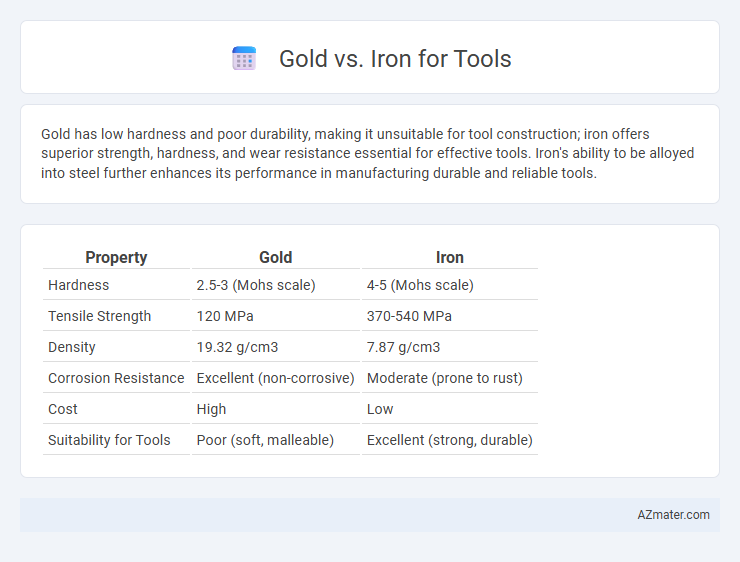Gold has low hardness and poor durability, making it unsuitable for tool construction; iron offers superior strength, hardness, and wear resistance essential for effective tools. Iron's ability to be alloyed into steel further enhances its performance in manufacturing durable and reliable tools.
Table of Comparison
| Property | Gold | Iron |
|---|---|---|
| Hardness | 2.5-3 (Mohs scale) | 4-5 (Mohs scale) |
| Tensile Strength | 120 MPa | 370-540 MPa |
| Density | 19.32 g/cm3 | 7.87 g/cm3 |
| Corrosion Resistance | Excellent (non-corrosive) | Moderate (prone to rust) |
| Cost | High | Low |
| Suitability for Tools | Poor (soft, malleable) | Excellent (strong, durable) |
Introduction: Comparing Gold and Iron for Tools
Gold and iron differ significantly in hardness and durability, making iron far more suitable for tools requiring strength and longevity. Iron boasts a high tensile strength and resistance to wear, whereas gold's softness limits its practical use in toolmaking. The superior mechanical properties of iron enable it to withstand heavy-duty tasks, outperforming gold in tool performance and efficiency.
Historical Use of Gold and Iron in Tools
Gold's historical use in tools was limited due to its softness and malleability, making it unsuitable for cutting or structural purposes but valuable for ornamental and ceremonial tools in ancient civilizations like Egypt and Mesopotamia. Iron revolutionized toolmaking during the Iron Age, offering superior hardness, durability, and affordability, which enabled the production of farming tools, weapons, and construction equipment that significantly advanced human technology and society. Archaeological evidence from regions such as Europe, Asia, and Africa highlights iron's critical role in transitioning societies from bronze to more efficient and practical tools.
Physical Properties: Gold vs Iron
Gold exhibits excellent malleability and corrosion resistance but has low hardness and tensile strength, making it unsuitable for durable tools. Iron offers high strength, hardness, and wear resistance, essential for tool performance, although it is prone to oxidation without protective coatings. The density of gold (19.32 g/cm3) is significantly higher than iron (7.87 g/cm3), affecting tool weight and handling.
Strength and Durability Comparison
Gold tools exhibit low strength and poor durability due to their soft and malleable nature, often wearing down quickly under heavy use. Iron tools, in contrast, offer significantly higher strength and greater resistance to wear and tear, making them more suitable for demanding tasks and long-term use. The high tensile strength and hardness of iron alloys ensure prolonged tool life compared to gold counterparts.
Workability and Manufacturing Differences
Gold tools exhibit excellent malleability and corrosion resistance but lack the hardness and durability necessary for heavy-duty work, making them less practical for manufacturing tools. Iron, especially when alloyed into steel, offers superior strength, wear resistance, and ease of heat treatment, enabling the production of robust and long-lasting tools suited for a variety of industrial applications. The manufacturing process for iron tools involves forging, casting, and precise machining, whereas gold tools require more delicate handling due to their softness and higher material cost.
Corrosion Resistance: Which Lasts Longer?
Gold exhibits superior corrosion resistance compared to iron due to its inert nature and resistance to oxidation, ensuring longer-lasting tools in corrosive environments. Iron tools, while stronger and more durable under mechanical stress, are prone to rust and degradation when exposed to moisture and air, which significantly shortens their lifespan. In applications where exposure to corrosive elements is frequent, gold-coated or gold alloy tools maintain functionality and appearance much longer than iron counterparts.
Cost and Availability of Gold and Iron
Gold tools are significantly more expensive than iron tools due to gold's rarity and high market value, making them less accessible for large-scale or everyday use. Iron, being abundant and widely available, offers a cost-effective alternative with easier procurement and lower production expenses. The disparity in cost and availability directly influences the practicality of iron tools over gold in most industrial and artisanal applications.
Practical Applications in Modern Tools
Gold is rarely used in modern tools due to its softness and high cost, making it impractical for structural or cutting applications. Iron, especially in its alloyed form as steel, dominates tool manufacturing because of its strength, durability, and affordability. Practical applications of iron-based tools include construction equipment, automotive parts, and precision cutting instruments, where mechanical resilience and wear resistance are critical.
Environmental Impact and Sustainability
Gold tools have significantly higher environmental impacts due to intensive mining processes that consume vast amounts of energy and generate hazardous waste. Iron tools, derived from more abundant and recyclable materials, offer greater sustainability with lower carbon footprints and easier end-of-life recycling. Emphasizing iron over gold in tool manufacturing supports reduced ecological damage and promotes resource efficiency in the long term.
Conclusion: Choosing the Right Metal for Tools
Gold offers excellent corrosion resistance and malleability, making it unsuitable for durable tools due to its softness and low tensile strength. Iron, especially when alloyed as steel, provides superior hardness, strength, and wear resistance critical for effective tools. Selecting iron ensures a balance of durability and performance essential for most practical tool applications.

Infographic: Gold vs Iron for Tool
 azmater.com
azmater.com